Design and Decorating with The Golden Ratio
Have you ever wondered how interior designers create beautifully decorated spaces? Let’s break down some Design DIY and The Golden Ratio.
A beautifully designed room can mesmerize and leave a long-lasting impression. Moreover, a good designer can capture the story of the people living in a home, lift moods and create a feeling of luxury and welcome. While it is true that designers have a true talent and an eye for creating an aesthetically pleasing space, they also have guidelines and tools to guide their decisions. Let’s dive into one of my favorite design guidelines interior designers use to create proportion and balance. It’s a trick consistently seen within the beauty of nature and is the perfect formula for making anything pleasing to the human eye.

My Design Journey
Friends often ask me how I visualize and bring to reality the spaces to decorate and design. Admittedly, I have always been a nerd about creating beautiful, well-designed spaces. Since my first memories of having my own space to decorate, I have always loved interior design. As a child, I would sit and cut out magazine pictures and create glued-together mood boards to help me visualize and dream of spaces I would live in. It was an obsessive hobby that would send me spending hours upon hours studying pretty pictures of magazine-worthy rooms. As a result, I essentially learned my way into having an eye for a lovely design aesthetic. It’s a practice I still carry on to this day. I may not have known what I was studying at the time, but I’ve come to learn a vocabulary to describe what I saw in those pictures.
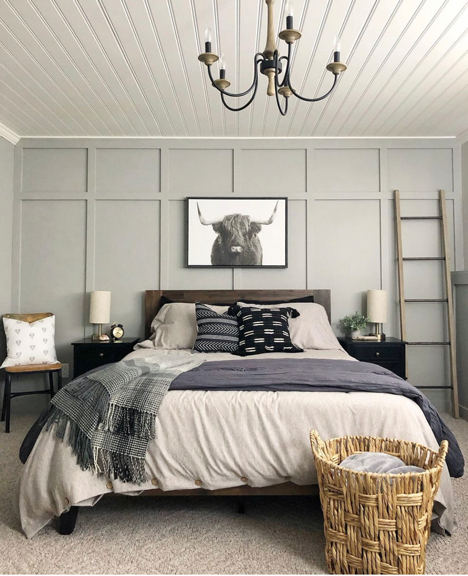
Design Guidelines
There are no rules regarding how you decorate your home. To love the spaces you live in, you must decorate them with things you love to have surrounding you. Nevertheless, there are guidelines designers use to create those beautiful rooms that make the magazines and inspire us. We look to the guidelines when we love the things we like but lack the cohesive, balanced feel we desire.
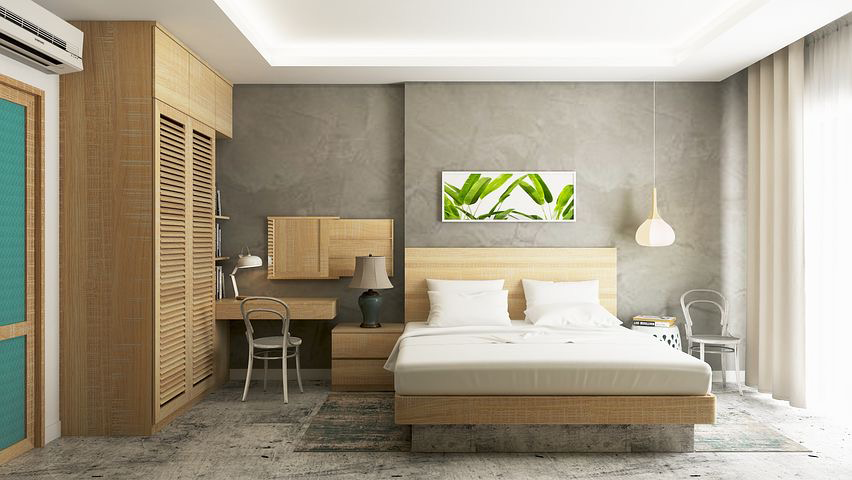
The Golden Ratio in Design
The Golden Rule is one of the best-kept secrets interior designers use intentionally or unplanned. It’s a formal lens designers use to improve their intuition for an aesthetic. Notably, they use the rule to create beautiful proportions, perfect symmetry, and visual balance in a room.
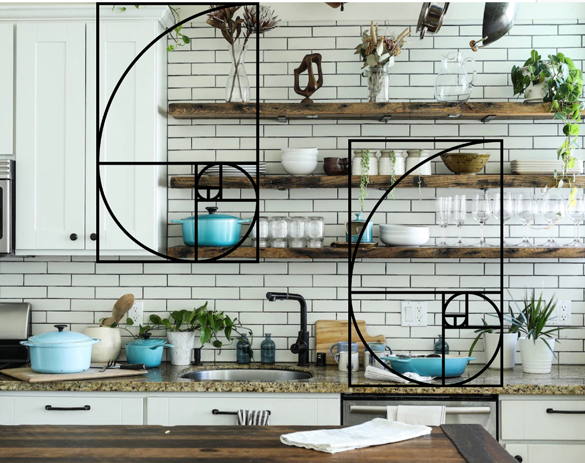
The Golden Ratio
The exact ratio is 1:1.1618. Mathematically, this ratio is one that we see in nature all the time. As it turns out, it is incredibly pleasing to the human eye. Nature inspires us in many ways, from the proportion of human bodies to the spiral of seashells. Consequently, using the ratio in decorating and designing spaces will produce well-balanced spaces with beautifully placed furniture, stunning color palettes, and an overall pleasing look.

Designing or decorating a room can be less mathematical. In contrast, the golden ratio can be applied by thinking of the fractions 2/3 and 1/3. Essentially, the rule invisibly divides space within a room or spot. The larger area should be ⅔ of the space and the home of more oversized items such as big pieces of furniture or larger pieces of decor. Then, ⅓ of the room balances out the look with smaller objects. When done well, this creates an aesthetically pleasing balance for the viewer representing the best proportions that transfer in the brain.
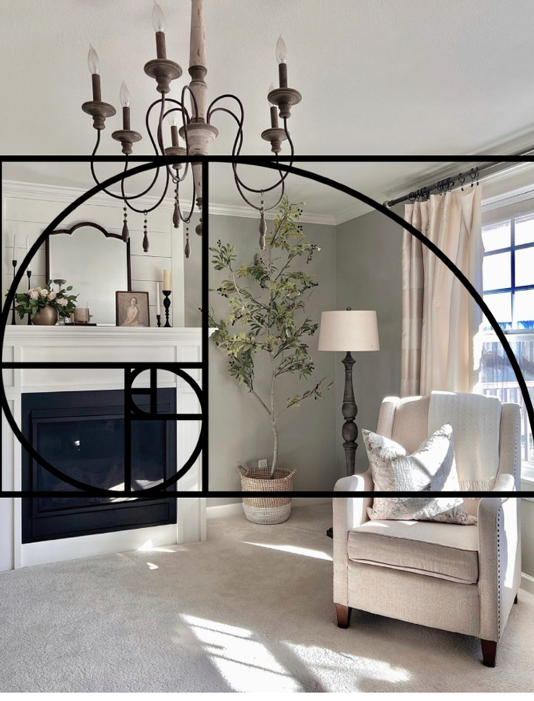
The Golden Rectangle, Spiral, and Circle
One of the easiest ways to apply the Golden Ratio is to use the golden rectangle, spiral, or circle to see how the division of ⅔ and ⅓ lays spatially. This way, the space is visually planned. When working with core pieces such as coffee tables, sofas, accent pieces, or artwork concerning each other, these golden ratio tools help us choose scale in the proper size. For example, choosing a coffee table that’s two-thirds the size of the sofa (or one-third if it’s round) gives a pleasing look proportionally. Additionally, accent chairs paired with a side table that is one-third the size appears balanced. Bedroom nightstands should be ⅓ the size of a bed to keep a balanced look.
Golden Ratio and Art Placement
The ratio also applies to hanging artwork. In other words, artwork should hold at least one-third or two-thirds the size of the wall. Another way to figure this out would be to size wall decor to at least 60% of the wall space. When considering which art pieces to display in a room, consider the golden ratio to get the perfect proportions. Make sure the piece you choose follows these ratio guidelines within the size of the wall space for the best balance.
Applying The Golden Spiral or Rectangle

The Golden Rectangle, as seen above, is a grid used to fill spaces in a rectangular shape using the ratio to balance and proportion the placement of furniture, architectural elements, or even decorating items on shelving. Certainly, it’s clear using the grid where the one-thirds and two-thirds divisions are. Thus, using the grid creates a way of weighting the space according to the ratio. Moreover, spacing in the rectangle is further divided into smaller parts using one-thirds and two-thirds again. To simplify, the rectangle is used to place items of larger proportions in the bigger squares while choosing smaller pieces to fit within the smaller shapes. The result will be a well-balanced style very pleasing to the eye.

The Golden Spiral works similarly but accounts for the aesthetics of a visual curve. Most importantly, the spiral allows for negative space and the stunning look it creates. Negative space is that space left uncluttered, so we can more easily focus on the focal points and allow our eyes to take in the calm or rested spaces simultaneously.
I’ve placed these ratio grids over the top of a few spaces I’ve decorated to illustrate how they appear in a decorated room. When I stand back and look at a space, I expect to get a feeling that aligns with an imaginary overlay of The Golden Ratio. I can always tell when I don’t get that feeling that my ratio is not aligned somewhere.
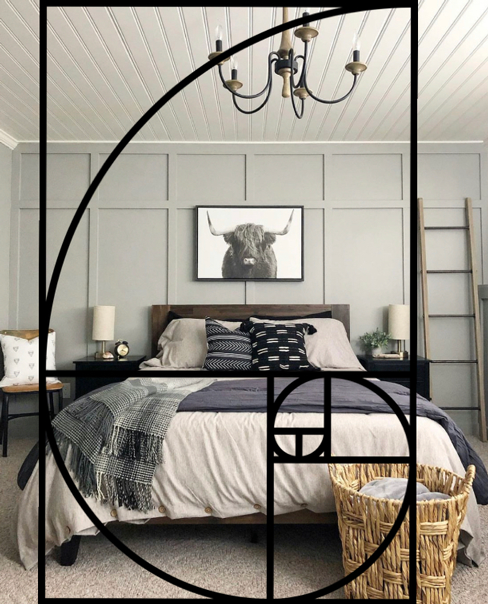
Achieving Balance
The golden ratio’s purpose is to create or achieve balance. Surprisingly, dividing visual spacing into halves or quarters will not accomplish this. Conversely, the seemingly irrational placements of two-thrids and one-third prove easy on the eyes, creating a feeling of comfort and calm. Chiefly, it allows for a dramatic focal point to draw in the viewer. Moreover, the golden ratio provides negative space where the eyes can rest.
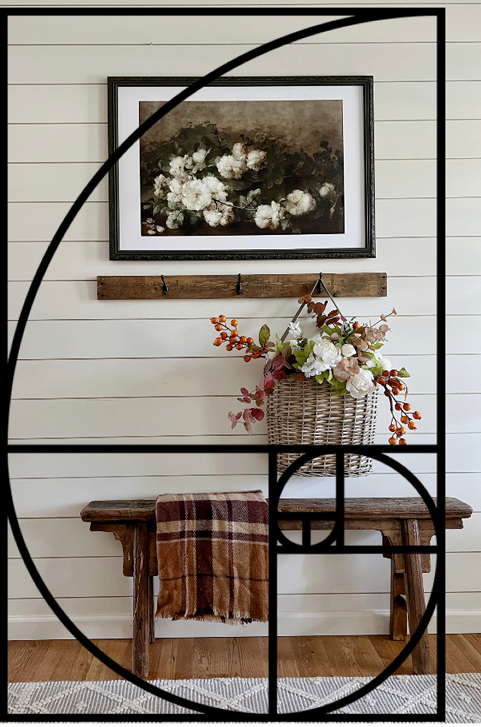
DIY Design, Golden Ratio, and Color Theory
Another use for The Golden Ratio is in applying color to spaces. My favorite way to think of it in color theory is to use the 60-30-10 rule, which is simply another way to use the ratio. In this case, color divides into percentages of use by 60, 30, and 10. Specifically, the primary color takes up 60% of the space. in this case, I prefer calming neutrals to maintain versatility and create a soothing mood. Next, a secondary color assumes 30% of the area. For instance, rugs, ceilings, and furniture consume this percentage of the paint. Again, neutrals are lovely here, but contrast and complement are a significant part of finishing this color portion. Finally, 10% of the color in the room comes in through accents. Namely, I love to add pops of fun, bold colors in the accents.

Design DIY and The Golden Ratio
Bend the Rules
You know what they say. Rules are made to be broken. Similarly, the Golden Ratio and color theory rules stand with this sentiment. New ideas are forged and accepted when rules are broken. Still, knowing the rules helps you make informed decisions so you can bend the rules to your preferences while maintaining a desirable look.
My husband, Mr. Lavender Brook Home, and I have been working for years, turning lackluster and hideous spaces into dreamy ones by designing and building them from scratch. We understand working with a small budget, so we have DIYed most of our work. This gives us a unique perspective. We understand what it takes to make a room beautiful without an endless budget. We also know what it feels like to splurge a little and create stunning spaces truly deserved. Don’t allow the overwhelm of understanding the ins and outs of designing a space to hold you back from having the one you dream of. Take advantage of the design service we offer with one click and start the process of making your home the dream space you deserve.
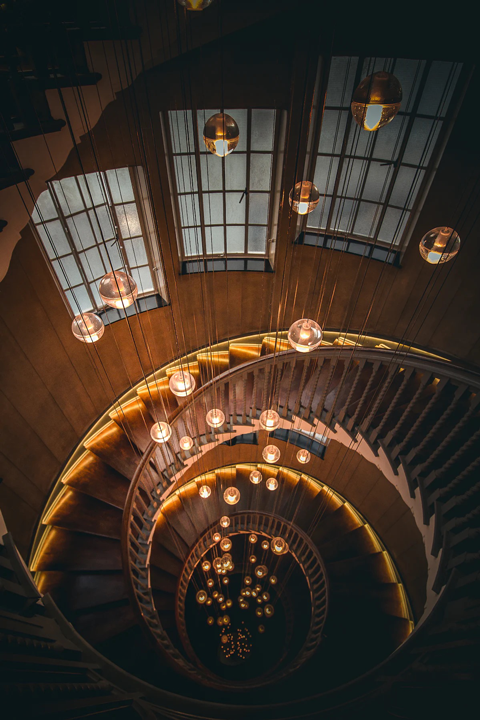
In conclusion, it’s important to feel comfortable and happy in the spaces we reside. Our spaces should rise to us and meet us with the mood, amenities, and overall sense of comfort we need to recharge and reconnect. Home should be a haven. To that end, I hope you can use this Design DIY and The Golden Ratio guide to help you finesse your style to fulfill those needs. Best wishes and thank you for supporting the blog.
~Get behind the scenes of the blog by joining me on Pinterest and Instagram.~
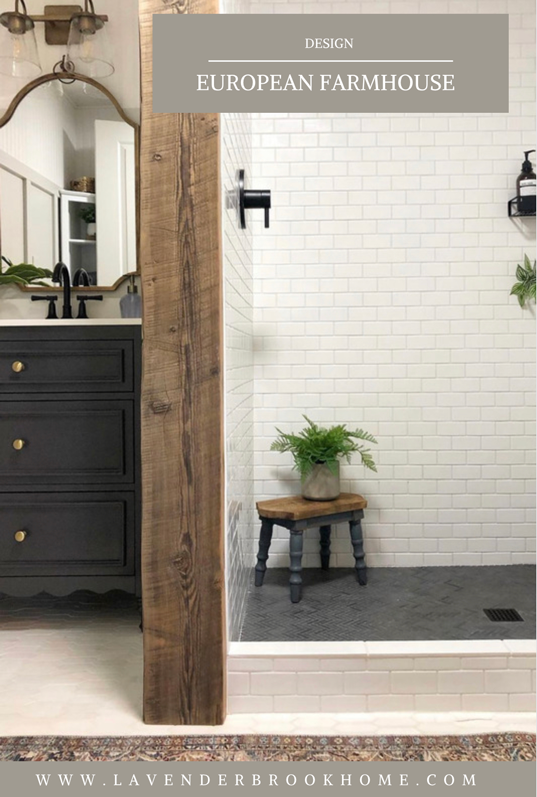
*This post contains some affiliate links for your convenience. I make a tiny portion of the sale with no additional cost to you whatsoever. Click here to read my full disclosure policy. Thank you for supporting this blog.*



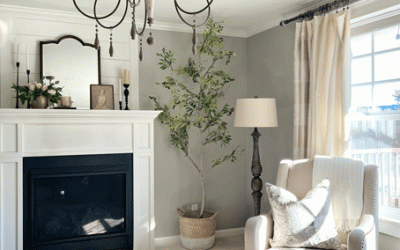
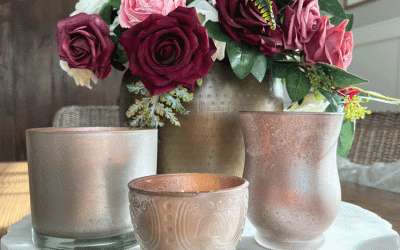
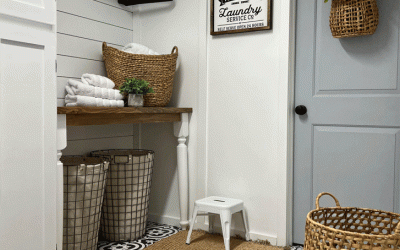
0 Comments